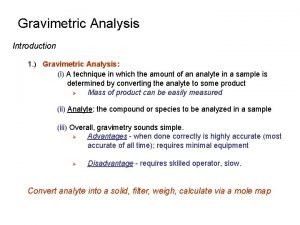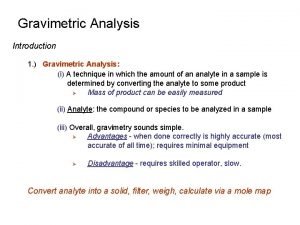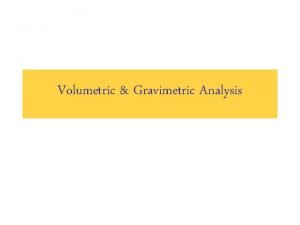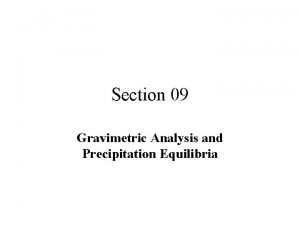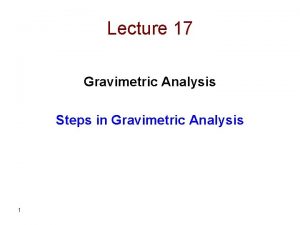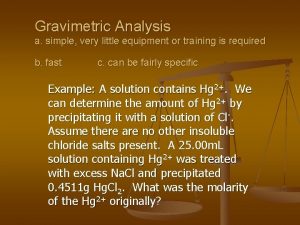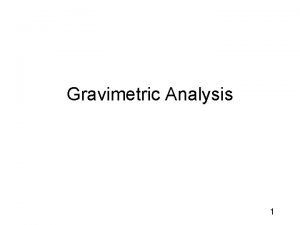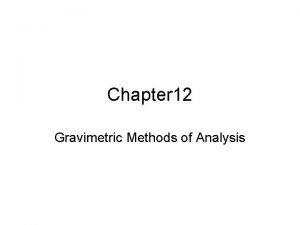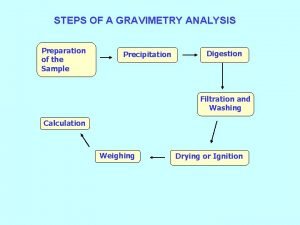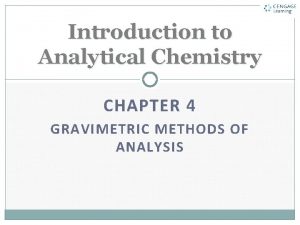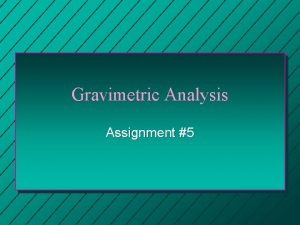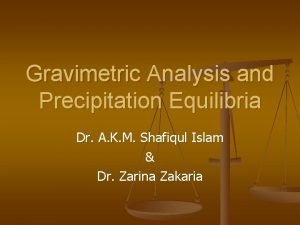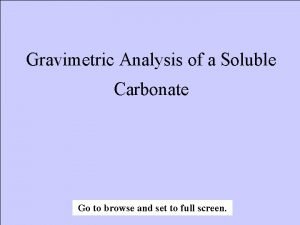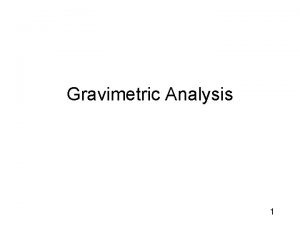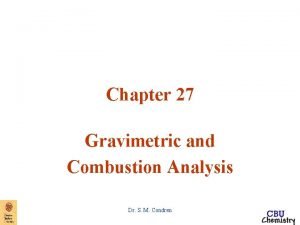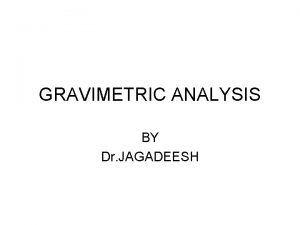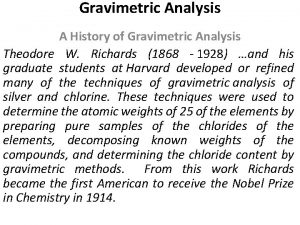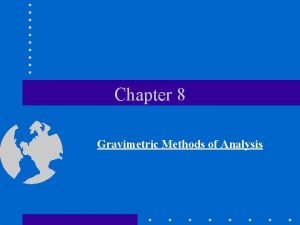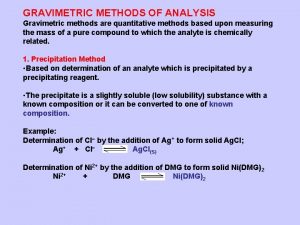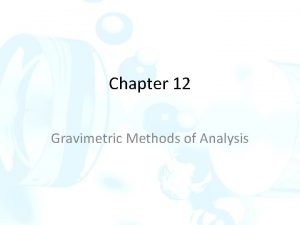Gravimetric Analysis Introduction 1 Gravimetric Analysis i A


















- Slides: 18

Gravimetric Analysis Introduction 1. ) Gravimetric Analysis: (i) A technique in which the amount of an analyte in a sample is determined by converting the analyte to some product Ø Mass of product can be easily measured (ii) Analyte: the compound or species to be analyzed in a sample (iii) Overall, gravimetry sounds simple. Ø Advantages - when done correctly is highly accurate (most accurate of all time); requires minimal equipment Ø Disadvantage - requires skilled operator, slow. Convert analyte into a solid, filter, weigh, calculate via a mole map

Gravimetric Analysis Introduction 1. ) Gravimetric Analysis: (iii) Example: Ø Determination of lead (Pb+2) in water Pb+2 Analyte Ø Ø + 2 Cl- Reagent Pb. Cl 2(s) Solid Product By adding excess Cl- to the sample, essentially all of the Pb+2 will precipitate as Pb. Cl 2. Mass of Pb. Cl 2 is then determined. - used to calculate the amount of Pb+2 in original solution

Gravimetric Analysis Introduction 1. ) Gravimetric Analysis: Example Calculation: What is the %KCl in a solid if 5. 1367 g of solid gives rise to 0. 8246 g Ag. Cl? Cl- + Ag+ Ag. Cl(s)

Gravimetric Analysis Types of Gravimetric Analysis 1. ) Combustion Analysis 2. ) Precipitation Combustion Analysis • Common method used to determine the amount of carbon and hydrogen • One modified method (Dumas Method) can also determine the amount of nitrogen in a sample • Technique is accurate and usable with a wide range of compounds. Ø Often one of the first methods used to characterize a new compound

Gravimetric Analysis Combustion Analysis 1. ) Principals: (i) Sample is heated in presence of Oxygen (O 2) Ø Converts carbon in sample to CO 2 Ø Converts hydrogen in sample to H 2 O C(sample) + O 2 2 H(sample) + ½O 2 Ø Ascarite D Pt CO 2 H 2 O Pt, Cu. O, Pb. O 2, or Mn. O 2 is used as a catalyst in this process (ii) As CO 2 and H 2 O form, leave the sample and flow through a series of chambers Ø Chambers contain chemicals that bind one or both of these products Ø Example: - P 4 O 10 can be used to absorb H 2 O - Ascarite can be used to absorb CO 2 - Ascarite - Sodium Hydroxide Coated Non-Fibrous Silicate

Gravimetric Analysis Combustion Analysis 2. ) Apparatus: (i) After the sample is completely burned: Ø Remove P 4 O 10 and Ascarite cartridges and weigh Ø If C and H are present in sample, both cartridges will increase in mass (ii) Amount of C and H in the original sample is determined from: Ø Knowing the amount of sample burned Ø Change in weight in each cartridge

Gravimetric Analysis Combustion Analysis 3. ) Example Calculation: A mixture weighing 7. 290 mg contained only cyclohexane, C 6 H 12 (FM 84. 159), and oxirane, C 2 H 4 O (FM 44. 053). When the mixture was analyzed by combustion analysis, 21. 999 mg of CO 2 (FM 44. 010) was produced. Find the weight percent of oxirane in the mixture.

Gravimetric Analysis Precipitation Analysis 1. ) Principals: (i) Reagent + Analyte Solid Product (collect and measure mass) (ii) Desired Properties of Solid Product Ø Should be very insoluble Ø Easily filterable (i. e. , large crystals) Ø Very Pure Ø Known and constant composition Few precipitates have all of these properties, but in most cases appropriate techniques can help optimize these qualities

Gravimetric Analysis Precipitation Analysis 2. ) Solubility: (i) The solubility of a precipitate can be decreased by: Ø Decreasing temperature of solution Ø Using a different solvent - usually a less polar or organic solvent (like dissolves like) Solubility vs. p. H Solubility vs. Common Ion Effect Solubility vs. Temperature

Gravimetric Analysis Precipitation Analysis 3. ) Gravimetric Analysis: (i) Governed by equilibrium: Ag. Cl Ksp = 1. 8 x 10 -10 Solubility of Ag. Cl = [Ag+] + [Ag. Cl 2 -] Cl- + Ag+ Ag. Cl(ag) ion pair formation Ag. Cl(aq) Ag. Cl(s) intrinsic solubility Ag. Cl +Cl- Ag. Cl 2 - complex ion formation

Gravimetric Analysis Precipitation Analysis 4. ) Filterability: (i) Want product to be large enough to collect on filter: Ø Doesn’t clog filter Ø Doesn’t pass through filter (ii) Best Case: Pure Crystals Brownian Motion (iii) Worst Case: Colloidal suspension Ø Difficult to filter due to small size Ø Tend to stay in solution indefinitely suspended by Brownian motion - usually 1 -100 nm in size Whether crystals or colloids are obtained depends on conditions used in the precipitation

Gravimetric Analysis Precipitation Analysis 5. ) Process of Crystal Growth: Crystal Growth (i) Two Phases in Crystal Growth Nucleation – molecules in solution come together randomly and form small aggregates Particle growth – addition of molecules to a nucleus to form a crystal

Gravimetric Analysis Precipitation Analysis 5. ) Process of Crystal Growth: (ii) Nucleation and Particle growth always compete for molecules/ions being precipitated. Ø If nucleation is faster than particle growth: - a large number of small aggregates occur giving colloidal suspensions Ø If particle growth is faster than nucleation: - only a few, large particles form giving pure crystals Want to Convert to Colloidal suspension Crystal formation

Gravimetric Analysis Precipitation Analysis 5. ) Process of Crystal Growth: (iii) Methods for Maximizing Crystal Growth (avoid colloids) Increase temperature of solution - increase amount of solute that can be in solution at equilibrium Add precipitating reagent slowly while vigorously mixing solution - avoids local high concentrations of solution Keep volume of solution large - keep concentration of analyte and precipitating reagent low Precipitate Ionic compounds in presence of electrolyte (0. 1 M HNO 3) - overcome charge repulsion and promotes particle growth Control solubility of solute through chemical means - by adjusting p. H - adding complexing agents - example: precipitation of Ca 2+ with C 2 O 42 - Avoid Colloidal Particle ([H+]) Note: As p. H changes, the solubility of Ca. C 2 O 4 changes C 2 O 42 - + H+ Ca 2+ + C 2 O 42 - HC 2 O 4 Ksp Ca. C 2 O 4(s)

Gravimetric Analysis Precipitation Analysis 6. ) Crystal Impurities: (i) Impurities are undesirable (known as co-precipitation) Ø Change the chemical composition of the precipitate Ø Creates errors in gravimetric analysis (iii) Types of Impurities Ø Adsorption, Occlusion, Inclusion Impurity placed in crystal instead of analyte Adsorbed to crystal surface Absorbed or trapped within crystal pockets

Gravimetric Analysis Precipitation Analysis 6. ) Crystal Impurities: (iii) Ways to Minimize Impurities Maximize crystal growth - large pure crystals decrease occlusions and adsorbed impurities Digestion: allowing precipitate to stand in mother liquor (precipitating solution), usually while being heated - promotes removal of impurities from crystal - increases size of crystals Wash precipitate, redissolve in fresh solvent and reprecipitate Color Impurity - helps decrease all types of impurities Add a masking agent to solution - keeps impurities from precipitating, but not analyte Masking agent Mg 2+ + CPCH Solid product Mn 2+ + 6 CN- Mn(CN)64 - precipitant

Gravimetric Analysis Precipitation Analysis 7. ) Final Preparation of Precipitates: (vi) Washing Precipitates from ionic compounds - need electrolyte in wash solution - keep precipitate from breaking up and redissolving (peptization) Electrolyte should be volatile - removed by drying - HNO 3, HCl, NH 4, NO 3, etc. Illustration: - Ag. Cl(s) should not be washed with H 2 O, instead wash with dilute HNO 3 (vii) Drying/Igniting Precipitates Many precipitates contain varying amounts of H 2 O - adsorbed from the air (i. e. hygroscopic) Precipitates are dried for accurate, stable mass measurements Precipitates are also ignited to convert to a given chemical form

Gravimetric Analysis Calculations in Gravimetric Analysis 8. ) Example Calculation A mixture containing only Al 2 O 3 (FM 101. 96) and Fe 2 O 3 (FM 159. 69) weighs 2. 019 g. When heated under a stream of H 2, Al 2 O 3 is unchanged, but Fe 2 O 3 is converted into metallic Fe plus H 2 O (g). If the residue weighs 1. 774 g, what is the weight percent of Fe 2 O 3 in the original mixture?
 Introduction to gravimetric analysis
Introduction to gravimetric analysis Introduction to gravimetric analysis
Introduction to gravimetric analysis Volumetric analysis problems
Volumetric analysis problems Factors affecting thermogravimetric analysis
Factors affecting thermogravimetric analysis Gravimetric factor calculator
Gravimetric factor calculator Steps in gravimetric analysis
Steps in gravimetric analysis Disadvantages of gravimetric analysis
Disadvantages of gravimetric analysis Inclusion in gravimetric analysis
Inclusion in gravimetric analysis Digestion gravimetric analysis
Digestion gravimetric analysis Gravimetric methods of analysis
Gravimetric methods of analysis Difference between gravimetric and volumetric analysis
Difference between gravimetric and volumetric analysis Co precipitation and post precipitation
Co precipitation and post precipitation What are the applications of gravimetric analysis
What are the applications of gravimetric analysis Define gravimetric factor
Define gravimetric factor What is post precipitation
What is post precipitation What makes water hard
What makes water hard Desicooler chemistry
Desicooler chemistry Inclusion in gravimetric analysis
Inclusion in gravimetric analysis Gravimetric combustion analysis
Gravimetric combustion analysis
